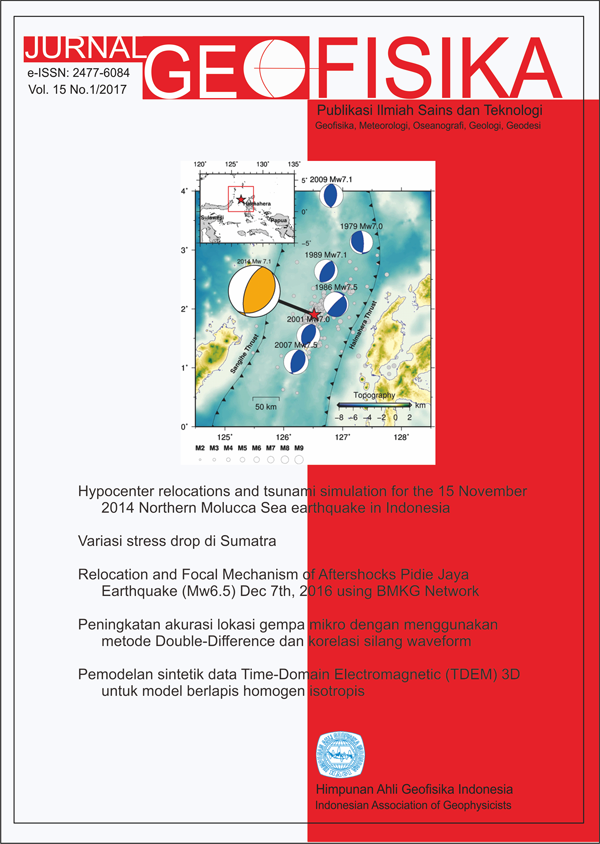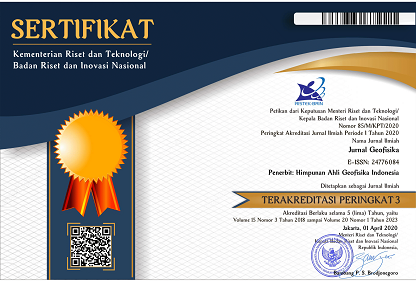Hypocenter relocations and tsunami simulation for the 15 November 2014 Northern Molucca Sea earthquake in Indonesia
The 2014 Northern Molucca Sea earthquake
Keywords
earthquake, The 2014 Northern Molucca Sea earthquake, hypocenter relocation, tsunami simulation, single fault model, tsunami early warningAbstract
A reverse fault earthquake (Mw 7.1) occurred in the Northern Molucca Sea, Indonesia, on 15 November 2014 at 2:31:40 UTC. The earthquake produced small tsunami waves that are recorded at Jailolo (9 cm), Tobelo (1 cm), and Menado (3 cm) tide gauges. The Indonesian Agency for Climatology, Meteorology, and Geophysics (BMKG) issued a timely (5 minutes after the earthquake) tsunami warning for the event. We used the teleseismic double‐difference seismic tomography method (teletomoDD) to relocate the hypocenters of the mainshock and the aftershocks. The relocated hypocenter of the mainshock for the 2014 Northern Molucca Sea earthquake is located at 1.923°N, 126.539°E, and depth of 48.87 km. In general, the relocated aftershock hypocenters are shallower than those from the BMKG catalog. The relocated hypocenters are distributed within a depth range of 6 to 64 km. The aftershock area from the relocated hypocenters is 80 km long and 55 km wide. The estimated seismic moment from the Global CMT solution (GCMT) was 4.75 × 1019 Nm. We simulated the tsunami from fault model of each GCMT nodal plane to find a fault model that can best explain the observed tsunami heights at Jailolo, Tobelo, and Menado tide gauges. The best single fault model for this event is dipping to the west, has fault length, width, and slip amount of 47 km, 25 km, and 1.16 m, respectively. The K value calculated using the observed and simulated tsunami heights for this best model is 1.026, suggests a very good fit to tsunami observations.
References
Bird, P. (2003). An updated digital model of plate boundaries.Geochemistry, Geophysics, Geosystems,4(3).
Blaser, L., Krger, F., Ohrnberger, M., & Scherbaum, F. (2010). Scaling relations of earthquake source parameter estimates with special focus on subduction environment. Bulletin of the Seismological Society of America,100(6), 2914-2926.
Gunawan E, Kholil M, Meilano I (2016) Splay-fault rupture during the 2014 Mw7.1 Molucca Sea, Indonesia, earthquake determined from GPS measurements. Phys Earth Planet Inter 259:2933. doi:10.1016/j.pepi.2016.08.009.
Gusman, A. R., Tanioka, Y., Kobayashi, T., Latief, H., & Pandoe, W. (2010). Slip distribution of the 2007 Bengkulu
earthquake inferred from tsunami waveforms and InSAR data.Journal of Geophysical Research: Solid Earth,115(B12).
Gusman, A. R., Satake, K., & Harada, T. (2017a). Rupture process of the 2016 Wharton Basin strikeslip faulting
earthquake estimated from joint inversion of teleseismic and tsunami waveforms.Geophysical Research Letters,44(9), 4082-4089.
Gusman, A. R., Satake, K., Shinohara, M., Sakai, S. I., & Tanioka, Y (2017b). Fault Slip Distribution of the 2016
Fukushima Earthquake Estimated from Tsunami Waveforms.Pure and Applied Geophysics, doi: 10.1007/s00024-
017-1590-2.
Iida, K., Cox, D. C., & Pararas-Carayannis, G. (1967).Preliminary catalog of tsunamis occurring in the Pacic Ocean, Hawaii Institute of Geohysics Honolulu, No. HIG-67-10.
Kennett, B. L. N., Widiyantoro, S., & Hilst, R. V. D. (1998). Joint seismic tomography for bulk sound and shear wave speed in the Earth's mantle.Journal of Geophysical Research: Solid Earth,103(B6), 12469-12493.
Koketsu, K., & Sekine, S. (1998). Pseudo-bending method for three-dimensional seismic ray tracing in a spherical
earth with discontinuities.Geophysical Journal International,132(2), 339-346.
Murotani, S., Satake, K., & Fujii, Y. (2013). Scaling relations of seismic moment, rupture area, average slip, and asperity size for M 9 subductionzone earthquakes. Geophysical Research Letters,40(19), 5070-5074.
Nugraha, A. D., Shiddiqi, H. A., Widiyantoro, S., Puspito, N. T., Triyoso, W., Wiyono, S., Daryono, Wandono, Rosalia, S. (2017). Hypocenter Relocation of Earthquake Swarm in West Halmahera, North Molucca Region, Indonesia by using Double-Difference Method and 3D Seismic Velocity Structure. IOP Con. Series: Earth and Environmental Science 62 (2017) 012053, doi: 10.1088/1755-1315/62/1/012053.
Nugraha, A. D., Shiddiqi, H. A., Widiyantoro, S., Ramdhan, M., Wandono, Sutiyono, Handayani, T., and Nugroho, H. (2015). Preliminary results of teleseismic double-difference relocation of earthquakes around Indonesian archipelago region. AIP Conference Proceedings 1658, 030002 (2015), doi: 10.1063/1.4915010.
Okada, Y. (1985). Surface deformation due to shear and tensile faults in a half-space.Bulletin of the seismological society of America,75(4), 1135-1154.
Pesicek JD, Thurber CH, Widiyantoro S, et al (2008) Complex slab subduction beneath northern Sumatra. Geophys Res Lett 35:L20303. doi: 10.1029/2008GL035262
Pesicek, J. D., Thurber, C. H., Zhang, H., DeShon, H. R., Engdahl, E. R., & Widiyantoro, S. (2010). Teleseismic
doubledierence relocation of earthquakes along the SumatraAndaman subduction zone using a 3D model. Journal of Geophysical Research: Solid Earth,115(B10).
Setiyono, U., Gusman, A. R., Satake, K., & Fujii, Y. (2017). Pre-computed tsunami inundation database and forecast simulation in Pelabuhan Ratu, Indonesia.Pure and Applied Geophysics, doi: 10.1007/s00024-017-1633-8.
Silver, E. A., & Moore, J. C. (1978). The Molucca sea collision zone, Indonesia.Journal of Geophysical Research:
Solid Earth,83(B4), 1681-1691.
Shiddiqi, H. A., Widiyantoro, S., Nugraha, A. D., Ramdhan, M., Wiyono, S. H., and Wandono. (2016). Analysis of Mw 7.2 2014 Molucca Sea Earthquake and its aftershocks. AIP Conference Proceedings 1730, 020010 (2016), doi:
10.1063/1.4947378.
Shiddiqi, H. A., Widiyantoro, S., Nugraha, A. D., Ramdhan, M., Wandono, Sutiyono, Handayani, T., Nugroho, H. (2015). Preliminary result of teleseismic double-dierence relocation of earthquakes in the Molucca collision zone with a 3D velocity model. AIP Conference Proceedings 1658, 030011 (2015), doi: 10.1063/1.4915019.
Um, J., & Thurber, C. (1987). A fast algorithm for two-point seismic ray tracing.Bulletin of the Seismological Society of America,77(3), 972-986.
Waldhauser, F., & Ellsworth, W. L. (2000). A double-difference earthquake location algorithm: Method and ap-
plication to the northern Hayward fault, California.Bulletin of the Seismological Society of America,90(6), 1353-1368.
Weatherall, P., Marks, K. M., Jakobsson, M., Schmitt, T., Tani, S., Arndt, J. E., ... & Wigley, R. (2015). A new digital
bathymetric model of the world's oceans.Earth and Space Science,2(8), 331-345.
Yulianto, Y., Nugraha, A. D., Wandono, and Wiyono, S. (2017). Hypocenters relocation using double-dierence
method around Molucca collision zone. AIP Conference Proceeding 1857, 020002 (2017), doi: 10.1063/1.4987044.
Zhang H, Thurber CH (2003) Double-dierence tomography: The method and its application to the Hayward Fault, California. Bull Seismol Soc Am 93:18751889.

This work is licensed under a Creative Commons Attribution 4.0 International License.
The copyright of all articles belongs to the authors. All other copyrights is held by the Journal











